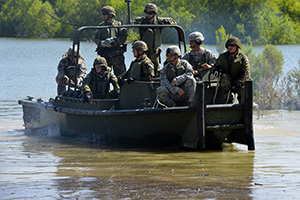 Service members from the Texas National Guard's 386th Engineer Battalion, the 551st Multi Role Bridge Company, U.S. Army's 20th Engineer Battalion, and the Czech Republic 15th Engineer Regiment conduct a wet gap crossing June 20, 2016, at Fort Hood, Texas, as part of a Multinational Lumberjack River Exercise. Through the States’ Partnership Program, the Texas Army National Guard currently works alongside the Czech Republic and Chile to conduct military operations in support of defense security goals. (U.S. Army National Guard photo by Sgt. Elizabeth Pena/Released)
Service members from the Texas National Guard's 386th Engineer Battalion, the 551st Multi Role Bridge Company, U.S. Army's 20th Engineer Battalion, and the Czech Republic 15th Engineer Regiment conduct a wet gap crossing June 20, 2016, at Fort Hood, Texas, as part of a Multinational Lumberjack River Exercise. Through the States’ Partnership Program, the Texas Army National Guard currently works alongside the Czech Republic and Chile to conduct military operations in support of defense security goals. (U.S. Army National Guard photo by Sgt. Elizabeth Pena/Released)
Texas Guardsmen partner with Czech Republic engineers
Story by: Sgt. Elizabeth Pena
Posted: June 21, 2016
FORT HOOD, Texas – Engineers from the Texas Army National Guard’s 386th Engineer Battalion, 551st Multi Role Bridge Company, Czech Republic’s 15th Engineer Regiment and U.S. Army’s 20th Engineer Battalion conducted a Multinational Lumberjack River Exercise, June 21, 2016.
“This is the first time we have worked with an active duty engineer battalion in order to conduct a gap crossing exercise along with the foreign national soldiers,” said Texas Guardsman Lt. Col. Anthony J. Miles, commander for the 386th Eng. Batt.
The Texas National Guard is currently partnered with the Czech Republic and Chile under the State Partnership Program. Through SPP, Guardsmen conduct military-to-military engagements with multinational allies in support of defense security goals.
“It’s an honor to see Czech soldiers exercising alongside American soldiers,” said Petr Gandalovic, Ambassador for Czech Republic, during his visit to Fort Hood. “This is important because we all keep the same values and we all have to be responsible for each other, and the responsibility translates into capability of doing something real.”
Service members coordinated with each other to conduct a wet gap crossing. When a large body of water is blocking ground transportation, this is used to transport military supplies, personnel and or vehicles across a lake or river.
“The concept of the operation was to conduct rafting operations and project combat power across the far shore,” said Capt. Jacob Patterson an operations planner for the 386th Eng. Batt.
During the exercise, soldiers worked on ground to free-launch bays and bridges into the lake, and conducted air operations to sling load a bridge, several bays and ramps.
“The aircraft is doing airdrops,” said Sgt. Randall McMorris, with the 551st MRBC, non-commissioned officer in charge for the shore portion of the exercise. “We have a landing zone up the road, and they will attach a ramp and boat and drop it in the water.”
Once all the equipment was in the lake, service members connected the bays and ramps to form a floating bridge. Each bridge is made up of five interior bays and two ramps, referred to as a seven float.
“With that seven float you can push the heaviest piece of army equipment across, said Patterson. “We pushed M113’s, M2A2 Bradley’s, Up-Armored Humvee’s, a buffalo and a husky, which is a route clearance piece of equipment,” said Patterson.
Soldiers built, two bridges to transport equipment across the lake and used real-world conditions as practice for maneuver operations.
“This year the water levels are much higher than they were last year,” said Patterson. “It’s about 5 to 10 ft. higher than what we experienced last year, so that in itself is a challenge because we’ve had to change the operation multiple times based on Mother Nature and what we were given to work with.”
Last year the Texas National Guard’s 386th Eng. Batt., went to the Czech Republic to conduct a similar exercise using the Czechs’ equipment. This year, they came the U.S.
“It’s one of the greatest experiences I’ve had so far,” said 2nd Lt. Josef Kurfirt a platoon leader with the Czech Republic’s 15th Eng. Reg. “The most valuable thing for us is for us to see this bridge, work with their equipment and vehicles, and compare technologies and procedures with them.”
The State Partnership Program has been successfully building relationships for over 20 years. The U.S. currently works with 76 nations around the globe.
“This is extremely important in today’s environment to be able to work with interagency and non-governmental organizations with multinational forces, to include our own,” said Miles. “It’s an excellent training opportunity because that’s how we fight overseas. We get rolled up and assigned to other active duty units so if we can practice that in a peacetime situation it makes it that much easier in a wartime situation.”